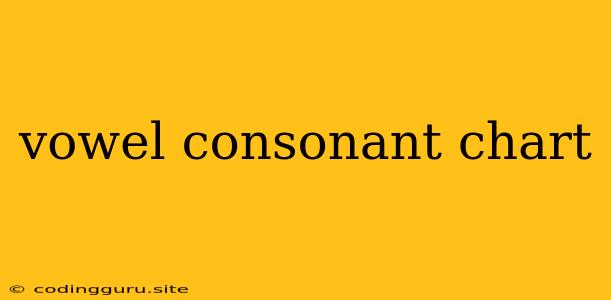Unlocking the Building Blocks of Speech: A Guide to the Vowel and Consonant Chart
Understanding the fundamental components of language is essential for anyone interested in linguistics, phonetics, or simply improving their pronunciation. One of the most helpful tools for this journey is the vowel and consonant chart, a visual representation of the sounds we make when speaking.
What is a Vowel and Consonant Chart?
The vowel and consonant chart is a diagram that categorizes and arranges the sounds of a language based on their articulation, that is, how they are produced by the mouth and vocal cords. It essentially maps the different positions of the tongue and lips involved in creating each sound.
Vowels are sounds produced with an open vocal tract, allowing air to flow freely. They are generally characterized by the height and forwardness of the tongue in the mouth. Consonants, on the other hand, are produced with some kind of obstruction in the vocal tract, restricting the airflow. This obstruction can be caused by the tongue touching the teeth, roof of the mouth, or lips.
Decoding the Chart: Vowels
The vowel chart typically uses a grid-like structure to represent the different vowel sounds. The horizontal axis represents the position of the tongue in the mouth – from front to back. The vertical axis represents the height of the tongue – from high to low.
For example, in the English vowel chart, the sound /i/ (as in "see") is located in the upper left corner, indicating a high and front tongue position. Conversely, the sound /ɑ/ (as in "father") is located in the lower center of the chart, signifying a low and central tongue position.
Decoding the Chart: Consonants
The consonant chart is more complex than the vowel chart as it takes into account not only the position of the tongue and lips but also the manner of articulation.
Manner of articulation refers to how the airflow is obstructed. This can be through:
- Stops: A complete closure of the vocal tract, followed by a release of air (e.g., /p/, /t/, /k/).
- Fricatives: A narrow constriction in the vocal tract, creating friction as air passes through (e.g., /f/, /θ/, /s/).
- Affricates: A combination of a stop and a fricative (e.g., /tʃ/, /dʒ/).
- Nasals: Air flows through the nose (e.g., /m/, /n/, /ŋ/).
- Liquids: Partial obstruction, but still allowing some airflow through the mouth (e.g., /l/, /r/).
- Glides: A quick movement of the tongue from one position to another (e.g., /w/, /j/).
The consonant chart usually includes multiple rows and columns, with each row representing a different manner of articulation and each column representing a different place of articulation, which refers to where the obstruction is formed in the vocal tract.
How Can the Vowel and Consonant Chart Help You?
The vowel and consonant chart is a powerful tool for learners of any language, whether they are just starting out or are already fluent. Here are some ways it can help:
- Improve pronunciation: By understanding the articulation of each sound, you can better control your tongue and lips, leading to clearer and more accurate pronunciation.
- Identify and correct errors: When you know where sounds are located on the chart, you can easily spot any errors in your pronunciation.
- Learn new languages: The vowel and consonant chart is a universal tool, applicable to any language. Understanding the chart can help you quickly identify the differences in sounds between languages.
- Expand your vocabulary: The chart allows you to visualize the relationship between sounds, helping you understand the patterns of sound changes within a language.
Tips for Using the Vowel and Consonant Chart:
- Start with the basics: Focus on learning the most common vowel and consonant sounds first.
- Use a visual aid: Look for online charts or print out a copy of the chart to refer to.
- Practice regularly: Consistent practice is key to mastering the sounds.
- Focus on one sound at a time: Don't try to learn everything at once.
- Record yourself: Listen to your own voice to identify any errors.
- Seek help from a professional: A speech therapist or language teacher can provide guidance and feedback.
Examples of Vowel and Consonant Charts
There are many different versions of vowel and consonant charts available online and in textbooks. Some common charts include:
- The International Phonetic Alphabet (IPA) Chart: This is the most widely used chart for representing speech sounds.
- The English Vowel and Consonant Chart: This chart specifically focuses on the sounds of the English language.
- Charts for other languages: Charts are available for languages such as Spanish, French, Mandarin Chinese, and Japanese.
Conclusion
The vowel and consonant chart is an invaluable tool for anyone interested in the mechanics of language. By understanding the different sounds and their articulation, you can gain a deeper understanding of language and improve your ability to speak and understand it. Whether you are a language learner, a linguist, or simply someone interested in the intricacies of human communication, the vowel and consonant chart is a key resource for unlocking the building blocks of speech.
